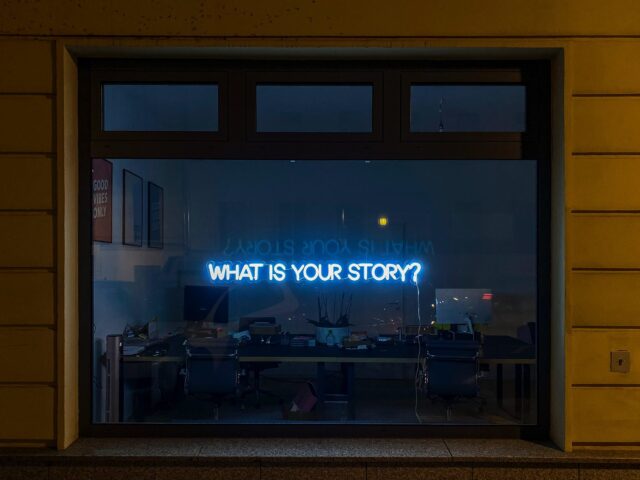In a world where new digital experiences are constantly being created, we often find ourselves inundated with information, products, and endless brand content. It can be challenging to stand out in such a crowded landscape, but storytelling can breathe life into otherwise mundane interfaces; by sharing compelling narratives, we can create immersive experiences that evoke emotions and inspire action from an audience.
Telling a compelling story can be the difference between a user scrolling past your content and engaging with it. To truly engage with your audience online, storytelling must be combined with experience design. Experience design (UX) is all about creating meaningful and memorable experiences for users across all digital touch-points, with storytelling understandably being an important factor when it comes to crafting memorable experiences.
Let’s delve deeper into why it’s so important to tell a story through your digital experience design, how it can create a lasting impact and how to create your own narrative.
What is experience design?
Experience design is the process of designing a user journey when interacting with a product, service or environment. A user-centric design involves using design elements and considerations to create a holistic experience that aligns with a user’s needs and desires. To create a meaningful and holistic experience, it’s necessary to recognise that the user journey started long before they encountered your product or service, and will continue for a long while after.
Understanding the entire user journey will show you where your product or service fits in this journey to improve the lives of users. Once you understand this, you can begin creating a story and messaging that will resonate most strongly with the user and demonstrate the value of your product or service to them and their lives.
When telling a brand story, common elements in experience design will become the building blocks for the narrative:
- User research: understanding an audience’s desires, needs and pain points. How will you capture their imagination and spark interest?
- Information architecture: organising and structuring content in a way that is easy for users to navigate. What will the chapters be in your story? How are you going to take them on a journey.
- Visual design: design elements will create a visual hierarchy that guides the user through your story. Using colour, typography and layout will help break up your narrative.
The power of storytelling
When we hear a story, our brains release oxytocin – a hormone associated with positive feelings such as trust and bonding. This emotional engagement is critical to connecting the brand (or storyteller) with their audience.
At its core, experience design is about people – their needs, emotions, and aspirations. Storytelling therefore creates the emotional engagement designers need to tap into the human psyche and create narratives that resonate with people and build trust.
How storytelling enhances digital experiences
In a digital environment, storytelling can help connect with an audience and emotionally involve them in the content they are faced with. Pictures, video and copy are prescribed meaning which piques users’ knowledge and interest in your brand. Ultimately, storytelling techniques guide users through a journey while providing them with a clear understanding of a brand and its values, leading to a positive experience and increased engagement and loyalty.
Incorporating storytelling into digital experiences also helps to create a more immersive and interactive environment. Storytelling can be used to create a sense of excitement and anticipation, encouraging users to explore further into a brand.
For example, if you land on a brand’s ecommerce homepage and you see a list of products and prices, your full attention and interest isn’t going to be captured. If you land on a homepage with a narrative explaining why the products were made, who made it, what makes the brand so unique and customer testimonials, along with a video showcasing the products features and stats about how it will benefit your life, you’re much more likely to have a positive reaction. That’s because you’re beginning to build an emotional connection to the brand and its product.
So, how do we create compelling narratives through experience design?
1. Know your audience
Conduct user research to understand your audience’s needs, desires and pain points. This information will help you create a narrative that resonates with them. The story you are telling should be a solution to a problem they have or something they desire.
2. Plan your story
Planning a story starts by defining the core theme or message you want to convey. How do you want to make your users feel when they interact with your brand? Do you want to create excitement? Do you want to create a feeling of empathy? Ultimately, you want your users to envision owning your product or using your service and engage with that feeling and how it will enhance their lives.
For example, if you were to describe an ice cream in its basic reality, it would just be frozen cream that you eat, but if you describe it as a delicious treat best enjoyed on a hot summer day while you relax on the beach, it paints a picture of something much more desirable. Your core theme needs to provide something worthwhile or desirable for users.
3. Choose the right medium
Understanding the platform your story is being told on is essential; whether it’s a website, social media, or a specialised interactive platform, each demands a different approach and has different features to utilise.
A video may be the perfect medium for a brand story that requires visual storytelling, while a blog post may be the best choice for a more in-depth and informative narrative. Social media platforms are ideal for short-form storytelling, and interactive websites may be the best choice to create an immersive experience or to help users flow through a large amount of information.
Research the platform you’re using and other resources before designing and telling your story.
4. Utilise visual storytelling
Use design elements such as colour, typography and layout to create a visual hierarchy that guides your audience through your story.
Colours can evoke emotions and set the tone for the story; you should choose colours that align with the story’s mood and message. Typography can be used to create a visual hierarchy that guides the user through the story, with different font sizes, weights, and styles creating a visual flow. Layout can be used to create visual interest and break up the narrative, while images and videos can be used to create context and make the story more relatable.
Visual elements ultimately support the narrative, create context and provide additional information.
5. Test and iterate
An important part of experience design is testing and gathering real-time feedback from real users. By testing and iterating your narrative, you can identify areas for improvement and make changes to create a more engaging and effective narrative. This will ensure that your story remains relevant and resonates with the audience over time, driving engagement and conversion.
What does good storytelling look like?
Choose Love is a charity that supports refugees and displaced people around the world. Their aim is to receive donations to help support local organisations doing the most effective work.
By using storytelling techniques, the Choose Love charity website creates a clear understanding of their values and their impact on the world, resonating with users by making them feel as though they’re part of something much bigger than themselves by getting involved. The website’s experience design tells a powerful story that inspires users to take action and become a part of that story.
There’s an instant narrative right from the homepage of their website. Users are guided through a story that makes them feel good about donating; no feelings of guilt are associated, only an uplifting feeling of creating positive change is thread throughout the narrative. Users are greeted with the words “Choose Love,” and as they scroll down the page, along with powerful visuals and easy-to-digest information about the charity’s impact and stories from refugees.
Some key features that contribute to great storytelling through the site’s UX include:
- Well organised site architecture, making it easy for users to navigate and find information about the charity’s mission and how they can help. Three key statistics are quickly absorbed at the top of the page.
- Direct copy and messaging tells a story conveying the importance of their work.
- Imagery demonstrates the charity’s success; it shows children safe and support teams on the ground supporting displaced people and rebuilding homes.
- The colours are bright and happy, creating a sense of positivity and hope.
What’s stopping you from telling your story?
In today’s world of digital experiences, standing out amidst the endless stream of brand content is a challenge. Digital experience design is not just about creating visually pleasing interfaces but also about creating meaningful and memorable experiences that connect with users on an emotional level. Storytelling is an essential component of digital experience design that breathes life into your message.
Take advantage of the power of storytelling – get in touch if you need a hand creating your narrative.







